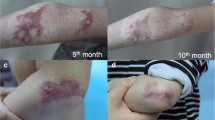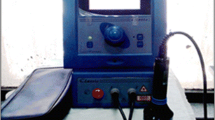Abstract
Background
Laser and other energy devices have been widely used in the minimally invasive treatment of scars. Among various technologies, Fractional Micro-Plasma Radio Frequency Technology (FMRT) has gained extensive consensus in the treatment of various types of scars and skin disorders, such as wrinkles, skin laxity, and pigmentation.
Objective
This study is a retrospective clinical trial aimed at assessing the effectiveness and safety of FMRT for hypertrophic burn scars treatment in the Asian population under different anesthesia methods.
Methods
A total of 104 patients with hypertrophic burn scars treated in our department from May 2018 to May 2022 were selected. Scar assessment scales were applied to observe changes in scars before and after FMRT treatment.
Results
A prospective study of 104 patients found that female patients were more likely to undergo laser treatment under general anesthesia (P < 0.05). Postoperative VSS total score, VSS total score difference, and immediate postoperative pain score were all better with general anesthesia compared to local anesthesia (P < 0.05). There were more significant improvements in scar color, vascular distribution, and flexibility (P < 0.05). When comparing the treatment outcomes between females and males, it was found that general anesthesia patients were superior to local anesthesia patients in terms of color score, vascular distribution score, flexibility score, and postoperative VSS total score 6 months after the final treatment. General anesthesia patients had a shorter hospital stay. Overall treatment evaluation was better for female general anesthesia patients than male patients.
Conclusion
General anesthesia combined with FMRT is an effective, safe, and more acceptable treatment method for hypertrophic burn scars in the Asian population.
Bullet points
In the Asian population, the combined use of general anesthesia and Fractional Micro-Plasma Radio Frequency Technology (FMRT) is an effective, safe, and accepted method for treating skin scars.
Level of Evidence II
This journal requires that authors assign a level of evidence to each article. For a full description of these Evidence-Based Medicine ratings, please refer to the Table of Contents or the online Instructions to Authors www.springer.com/00266.
Similar content being viewed by others
References
Santuzzi CH, Gonçalves Liberato FM, Fachini de Oliveira NF, Sgrancio do Nascimento A, Nascimento LR (2024) Massage, laser and shockwave therapy improve pain and scar pruritus after burns: a systematic review. J Physiother 70(1):8–15
Bombaro KM, Engrav LH, Carrougher GJ et al (2003) What is the prevalence of hypertrophic scarring following burns? Burns 29(4):299–302
Guillamat-Prats R (2021) The role of MSC in wound healing, scarring and regeneration. Cells 10(7)
Ogawa R (2022) The most current algorithms for the treatment and prevention of hypertrophic scars and keloids: a 2020 update of the algorithms published 10 years ago. Plast Reconstr Surg 149(1):79e–94e
Yan BY, Rambhia PH, Barilla S, Sharon VR (2023) Racial and ethnic diversity in clinical trials examining post-surgical scar cosmesis: a concise review. Int J Dermatol 62(4):e215–e217
Wat H, Wu DC, Chan HH (2017) Fractional resurfacing in the Asian patient: current state of the art. Lasers Surg Med 49(1):45–59
Liu W (2020) Emerging technologies in scar management: remodeling of post-surgical linear scar using microplasma radiofrequency. In: Téot L, Mustoe TA, Middelkoop E, Gauglitz GG (eds) Textbook on scar management: State of the art management and emerging technologies. Springer, Cham, pp 465–473
Zhang W, Liu Z, Zhu L et al (2019) Combining micro-plasma radio-frequency with hypofractionated electron-beam radiation as a novel treatment of keloids: a case series. Medicine 98(48):e18094
Seago M, Shumaker PR, Spring LK et al (2020) Laser treatment of traumatic scars and contractures: 2020 international consensus recommendations. Lasers Surg Med 52(2):96–116
Bentkover SH (2012) Plasma skin resurfacing: personal experience and long-term results. Facial Plast Surg Clin North Am 20(2):145–162, v–vi
Sanderson AR, Wu EC, Liaw LH, Garg R, Gangnes RA (2014) The effect of topical anesthetic hydration on the depth of thermal injury from the plasma skin regeneration device. Lasers Surg Med 46(2):127–131
Mustoe TA (2004) Scars and keloids. BMJ (Clinical research ed.) 328(7452):1329–1330
Altemir A, Boixeda P (2022) Laser treatment of burn scars. Actas Dermo-sifiliograficas. 113(10):938–944
Lan T, Xiao Y, Tang L, Hamblin MR, Yin R (2018) Treatment of atrophic acne scarring with fractional micro-plasma radio-frequency in Chinese patients: a prospective study. Lasers Surg Med 50(8):844–850
Lee YB, Lee JY, Ko HR, Kim JW, Yu DS (2013) Combination therapy using fractional micro-plasma radio-frequency treatment followed by a drug delivery system with a sonotrode in Korean patients. J Cosmetic Laser Therapy Official Publ Euro Soci Laser Dermatol 15(1):34–36
Kwon HH, Lee WY, Choi SC, Jung JY, Bae Y, Park GH (2018) Combined treatment for skin laxity of the aging face with monopolar radiofrequency and intense focused ultrasound in Korean subjects. J Cosmetic Laser Therapy Official Publ Euro Soci Laser Dermatol 20(7–8):449–453
Shu X, Wan R, Huo W et al (2022) Effectiveness of a radiofrequency device for rejuvenation of aged skin at home: a randomized split-face clinical trial. Dermatol Therapy 12(4):871–883
Lan T, Tang L, Xia A, Hamblin MR, Jian D, Yin R (2021) Comparison of fractional micro-plasma radiofrequency and fractional microneedle radiofrequency for the treatment of atrophic acne scars: a pilot randomized split-face clinical study in China. Lasers Surg Med 53(7):906–913
Sandin RH, Enlund G, Samuelsson P, Lennmarken C (2000) Awareness during anaesthesia: a prospective case study. Lancet (London, England). 355(9205):707–711
Furtado F, Hochman B, Farber PL, Muller MC, Hayashi LF, Ferreira LM (2012) Psychological stress as a risk factor for postoperative keloid recurrence. J Psychosom Res 72(4):282–287
Arfelli E, de Araujo S, Okada M et al (2011) Impact of corticosteroids on late growth of radiofrequency lesions in infant pigs: histopathological and electroanatomical findings. Europace 13(1):121–128
Wahlgren CF, Quiding H (2000) Depth of cutaneous analgesia after application of a eutectic mixture of the local anesthetics lidocaine and prilocaine (EMLA cream). J Am Acad Dermatol 42(4):584–588
Halachmi S, Orenstein A, Meneghel T, Lapidoth M (2010) A novel fractional micro-plasma radio-frequency technology for the treatment of facial scars and rhytids: a pilot study. J Cosmet Laser Ther 12(5):208–212
da Costa PTL, Echevarría-Guanilo ME, Gonçalves N, Girondi JBR, Gonçalves ADC (2021) Subjective tools for burn scar assessment: an integrative review. Adv Skin Wound Care 34(6):1–10
Shen S, Cai Y, Song X, Xiang W (2023) The efficacy of fractional carbon dioxide laser in surgical scars treatment: a system review and meta-analysis. Aesthetic Plast Surg 47(1):340–350
Choo AMH, Ong YS, Issa F (2021) Scar assessment tools: how do they compare? Front Surg 8:643098
Hawker GA, Mian S, Kendzerska T, French M (2011) Measures of adult pain: Visual Analog Scale for Pain (VAS Pain), Numeric Rating Scale for Pain (NRS Pain), McGill Pain Questionnaire (MPQ), Short-Form McGill Pain Questionnaire (SF-MPQ), Chronic Pain Grade Scale (CPGS), Short Form-36 Bodily Pain Scale (SF-36 BPS), and Measure of Intermittent and Constant Osteoarthritis Pain (ICOAP). Arthritis Care Res 63(Suppl 11):S240-252
Acknowledgments
Thank all authors for their contributions to clinical case collection and manuscript writing. Thanks for the cooperation of the patients and their families who participated in the case follow-up.
Funding
None.
Author information
Authors and Affiliations
Corresponding author
Ethics declarations
Conflict of interests
The authors declare that they have no conflicts of interest to disclose
Ethical Statement
The patients in this manuscript have given written informed consent to the publication of their case details.
Additional information
Publisher's Note
Springer Nature remains neutral with regard to jurisdictional claims in published maps and institutional affiliations.
Rights and permissions
Springer Nature or its licensor (e.g. a society or other partner) holds exclusive rights to this article under a publishing agreement with the author(s) or other rightsholder(s); author self-archiving of the accepted manuscript version of this article is solely governed by the terms of such publishing agreement and applicable law.
About this article
Cite this article
Meng, F., Fu, Q., Zhou, G. et al. Efficacy of Fractional Micro-plasma Radio Frequency Technology in Treating Hypertrophic Burn Scars in Asian Patients Under General Anesthesia: A Retrospective Study of 104 Cases. Aesth Plast Surg (2024). https://doi.org/10.1007/s00266-024-04018-w
Received:
Accepted:
Published:
DOI: https://doi.org/10.1007/s00266-024-04018-w




